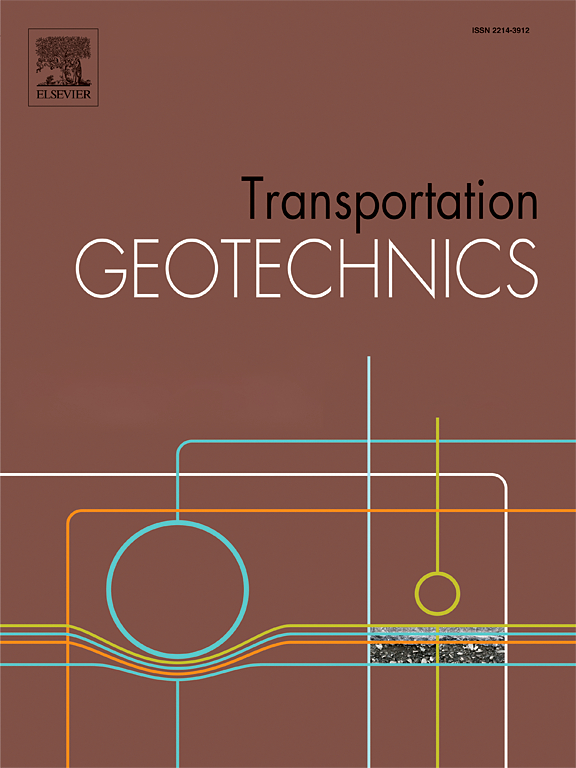基于经验主义约束神经网络和 SHapley Additive exPlanations 分析的高速铁路路基累积变形预测新方法
IF 4.9
2区 工程技术
Q1 ENGINEERING, CIVIL
引用次数: 0
摘要
了解高速铁路路基的长期变形对于解决变形问题和管理运营至关重要。机器学习方法通常用于预测路基累积变形(SCD)。然而,用于 SCD 预测的传统机器学习模型对新数据的泛化能力较差,并且缺乏可视化。因此,本研究提出了一种使用经验主义约束神经网络(ECNN)和 SHapley Additive exPlanations(SHAP)分析预测高速铁路 SCD 的新方法。首先,构建 SCD 预测数据集,并将其分为训练集和测试集。然后,利用训练集建立神经网络模型,并根据测试集的综合评分结果确定最优模型。最优模型将经验信息与神经网络相结合,并对损失函数进行修改,从而创建 ECNN 模型。最后,使用 SHAP 方法分析了 ECNN 模型的可解释性。结果表明,双向门控递归单元(Bi-GRU)模型是 CSI 值最高的最优模型,为 23。ECNN 模型对新数据的泛化能力优于 Bi-GRU,尤其是在训练数据有限的长期 SCD 预测中。贡献分析表明,影响预测的前两个特征是 St-1(54.4%)和 St-2(30.4%),这与消融分析的结果一致。研究结果可为高速铁路 SCD 预测提供新的参考。本文章由计算机程序翻译,如有差异,请以英文原文为准。
A novel method for subgrade cumulative deformation prediction of high-speed railways based on empiricism-constrained neural network and SHapley Additive exPlanations analysis
Understanding the long-term deformation of high-speed railway subgrade is essential for solving deformation issues and managing operations. Machine learning methods are commonly used to predict subgrade cumulative deformation (SCD). However, traditional machine learning models for SCD prediction have poor generalization to new data and lack visualization. Hence, this study proposes a novel method using an empiricism-constrained neural network (ECNN) and SHapley Additive exPlanations (SHAP) analysis for predicting SCD of high-speed railways. Firstly, the SCD prediction dataset is constructed and divided into training and test sets. Then, neural network models are developed using the training set, and the optimal model is determined based on the comprehensive scoring results on the test set. The optimal model couples empirical information into the neural network with loss function modification, to create the ECNN model. Finally, the interpretability of the ECNN model is analyzed using the SHAP method. The results indicate that the Bi-directional Gated Recurrent Unit (Bi-GRU) model is the optimal model with the highest CSI value of 23. The ECNN model outperforms the Bi-GRU in generalization to new data, especially in long-term SCD prediction with limited training data. Contribution analysis shows that the top two features influencing the prediction are St-1 (54.4%) and St-2 (30.4%), consistent with the findings of the ablation analysis. The research results can provide a new reference for predicting the SCD of high-speed railways.
求助全文
通过发布文献求助,成功后即可免费获取论文全文。
去求助
来源期刊

Transportation Geotechnics
Social Sciences-Transportation
CiteScore
8.10
自引率
11.30%
发文量
194
审稿时长
51 days
期刊介绍:
Transportation Geotechnics is a journal dedicated to publishing high-quality, theoretical, and applied papers that cover all facets of geotechnics for transportation infrastructure such as roads, highways, railways, underground railways, airfields, and waterways. The journal places a special emphasis on case studies that present original work relevant to the sustainable construction of transportation infrastructure. The scope of topics it addresses includes the geotechnical properties of geomaterials for sustainable and rational design and construction, the behavior of compacted and stabilized geomaterials, the use of geosynthetics and reinforcement in constructed layers and interlayers, ground improvement and slope stability for transportation infrastructures, compaction technology and management, maintenance technology, the impact of climate, embankments for highways and high-speed trains, transition zones, dredging, underwater geotechnics for infrastructure purposes, and the modeling of multi-layered structures and supporting ground under dynamic and repeated loads.
 求助内容:
求助内容: 应助结果提醒方式:
应助结果提醒方式:


